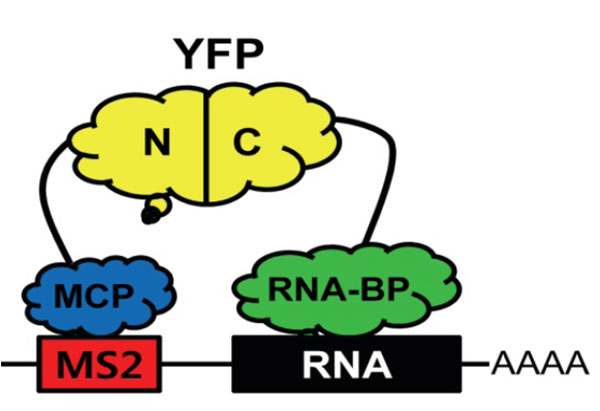As a leading company in biotechnology, Lifeasible offers advanced trimolecular fluorescence complementation (TriFC) assay systems for visualization of RNA-protein interactions in living cells. TriFC assay can be performed by transient expression in tobacco or other leaves. Molecular imaging of subcellular localization of RNA-protein complexes in plants is critical for understanding RNA-protein interactions and related biological processes.
Like bimolecular fluorescence complementation (BiFC) system, TriFC system depends on the reconstitution and activation of a fluorophore reporter. Specifically, the RNA “bait” sequence is fused to 6xMS2 sequence, which binds phage MS2 coat protein [MCP] specifically. MCP and RNA binding protein (RBP) are fused to two non-fluorescent fragments (FP-N and FP-C) of a fluorescent protein (FP), respectively. The vectors are co-transformed into protoplasts or plant leaves. When RBP interacts with the RNA “bait” sequence, the two non-fluorescent fragments are brought into close proximity and produce fluorescence. The fluorescence signal is detected by .confocal microscope or flow cytometer.
 Figure 1. Illustration of the TriFC system for RNA-protein interaction (Seo and Chua, 2017)
Figure 1. Illustration of the TriFC system for RNA-protein interaction (Seo and Chua, 2017)
We are at the forefront of the biotechnology revolution using new RNA-protein technologies which are capable of studying gene function and related biological processes. We pride ourselves on the quality of our one-stop TriFC system service from vector construction to data analysis. Our experts are devoted to providing optimal protocols to guarantee data reliability and cost-efficacy. Welcome to contact us for further information. We are more than happy to help you.
Reference
Lifeasible has established a one-stop service platform for plants. In addition to obtaining customized solutions for plant genetic engineering, customers can also conduct follow-up analysis and research on plants through our analysis platform. The analytical services we provide include but are not limited to the following:
Get Latest Lifeasible News and Updates Directly to Your Inbox
Mechanisms Regulating Plant Chloroplast Biogenesis
April 15, 2025